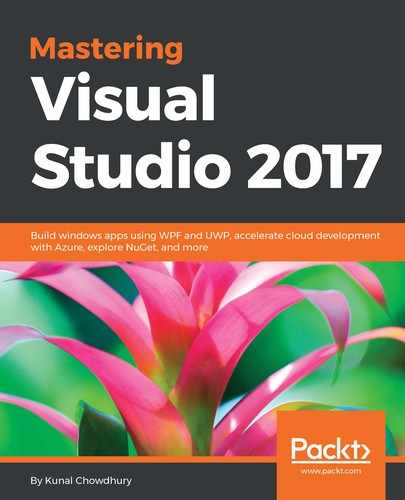.NET Core version 1.0 was first released in 2016 and now has support to work in Visual Studio 2015, update 3.3 or later, Visual Studio 2017, and Visual Studio Code only. The shared SDK component can be used to build, run, and publish applications using Visual Studio, Visual Studio Code, and the command line interface:

.NET Core is a subset of the .NET Framework, and contains its core features in both runtime and libraries. The .NET Framework, which was first released in 2002, is now running version 4.6.2. Until now, it was only targeted for the Windows platform, but, as time has passed, there has been a need to target it on different platforms. Using .NET Core components, you can build apps targeting the following platforms:
- Windows:
- Windows 7, 8, 8.1, 10
- Windows Server 2008 R2 SP1
- Windows Server 2012 SP1, R2
- Windows Server 2016
- Mac:
- Mac OS 10.11 or higher
- Linux:
- Red Hat Enterprise 7.2
- Ubuntu 14.04, 16.04, 16.10
- Mint 17
- Debian 8.2
- Fedora 23, 24
- Cent OS 7.1
- Oracle Linux 7.1
- Open SUSE 13.2, 42.1
It is composed of a .NET runtime, a set of framework libraries, a set of SDK tools, language compilers, and the .NET app host. Currently, you can use the C# and F# languages to build apps and libraries, and VB is on its way.
.NET Core 1.0 does not support all the app models of .NET Framework except the console and ASP.NET Core app models. It contains a smaller set of APIs from the .NET Framework as it is a subset of the other, but Microsoft is making changes to expand it further. Using .NET Core you can build apps that can execute on a device, the cloud, and on embedded/IoT devices. Following are the characteristics that best define .NET Core:
- It is an open-source platform hosted on GitHub with the MIT and Apache 2 license.
- Due to its flexible deployment nature, you can include .NET Core in your app (SCD) or install it side by side (FDD). We will discuss SCD and FDD later in this chapter.
- You can build cross-platform applications, which are currently supported by a few flavors of the Windows, Linux, and Mac operating systems.
- You can use the command-line interface to execute everything from project creation to publishing an app.
- As it is a subset of the .NET Framework it is compatible with that, along with Xamarin and Mono via the .NET Standard Library.
- Finally, it is supported by Microsoft and maintained by a vast .NET community.
